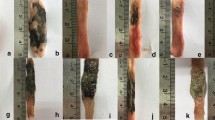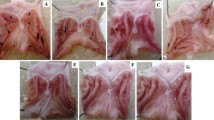Abstract
It is postulated that an enhanced production ofnitric oxide by inflamed intestine plays a role in thepathophysiology of active inflammatory bowel disease. Inthis study, systemic NOx concentrations and colonic nitric oxide synthase activity weredetermined in patients with ulcerative colitis orCrohn's disease. The relationship between these twoparameters and disease activity, as well as differences in nitric oxide synthase activity betweenulcerative colitis and Crohn's disease, were areas ofspecific focus. Patients with active ulcerative colitisand Crohn's disease had significantly elevated plasma NOx concentrations; a positivecorrelation was found between NOx values andinducible nitric oxide synthase activities in the activemucosa of these patients. In active ulcerative colitis,levels of inducible nitric oxide synthase were significantlyelevated in both normal and inflamed mucosa, althoughinducible nitric oxide synthase activity was higher inthe latter. These colonic inducible nitric oxidesynthase activities correlated well with the results ofendoscopic and histologic grading of inflammation. Therewas no increase in constitutive nitric oxide synthaseactivity in patients with active ulcerative colitis. However, constitutive nitric oxidesynthase activity was significantly increased in theinflamed mucosa in patients with Crohn's disease. InCrohn's disease, elevated inducible nitric oxidesynthase activity was found in both normal and inflamedmucosa, with no significant difference between thetissues. Such differences in nitric oxide production inthe colonic mucosa possibly reflect the significant differences in the pathophysiology andcharacteristic clinical features between ulcerativecolitis and Crohn's disease.
Similar content being viewed by others
REFERENCES
Moncada S, Higgs A: The L-arginine-nitric oxide pathway. N Engl J Med 329:2002-2012, 1993
Nathan C: Nitric oxide as a secretory product of mammalian cells. FASEB J 6:3051-3064, 1992
Stuehr DJ, Nathan CF: Nitric oxide: A macrophage product responsible for cytostasis and respiratory inhibition in tumor target cells. J Exp Med 169:1543-1555, 1989
Kurose I, Miura S, Fukumura D, Yonei Y, Saito H, Tada S, Suematsu M, Tsuchiya M: Nitric oxide mediates Kupffer cell-induced reduction of mitochondrial energization in hepatoma cells: A comparison with oxidative burst. Cancer Res 53:2676-2682, 1993
Beckman JS, Beckman TW, Chen J, Marshall PA, Freeman BA: Apparent hydroxyl radical production by peroxynitrite: Implications for endothelial injury from nitric oxide and superoxide. Proc Natl Acad Sci USA 87:1620-1625, 1990
Roediger WEW, Lawson MJ, Radcliffe BC: Nitrite from inflammatory cells: A cancer risk factor in ulcerative colitis? Dis Colon Rectum 33:1034-1036, 1990
Middleton SJ, Shorthouse M, Hunter JO: Increased nitric oxide synthesis in ulcerative colitis. Lancet 341:465-466, 1993
Miller MJS, Sadowska-Krowicka H, Chotinaruemol S, Kakkis JL, Clark DA: Amelioration of chronic ileitis by nitric oxide synthase inhibition. J Pharmacol Exp Ther 264:11-16, 1993
Yamada T, Sartor RB, Marshall S, Specian RD, Grisham MB: Mucosal injury and inflammation in a model of granulomatous colitis in rats. Gastroenterology 104:759-777, 1993
Boughton-Smith NK, Evans SM, Hawkey CJ, Cole AT, Balsitis M, Whittle BJR, Moncada S: Nitric oxide synthase activity in ulcerative colitis and Crohn's disease. Lancet 342:338-340, 1993
Grisham MB, Specian RD, Zimmerman TE: Effects of nitric oxide synthase inhibition on the pathophysiology observed in a model of chronic granulomatous colitis. J Pharmacol Exp Ther 271:1114-1121, 1994
Kirsner JB, Shorter RG: Inflammatory Bowel Disease, ed 3. Philadelphia, Lea & Febiger, 1988
Rachmilewitz D, Stamler JS, Bachwich D, Karmeli F, Ackerman Z, Podolsky DK: Enhanced colonic nitric oxide generation and nitric oxide synthase activity in ulcerative colitis and Crohn's disease. Gut 36:718-723, 1995
Hibi T, Ohara M, Kobayashi K, Brown WR, Toda K, Takaishi H, Hosoda Y, Hayashi A, Iwao Y, Watanabe M, Aiso S, Kawai Y, Tsuchiya M: Enzyme linked immunosorbent assay (ELISA) and immunoprecipitation studies on anti-goblet cell antibody using a mucin producing cell line in patients with inflammatory bowel disease. Gut 35:224-230, 1994
Best WR, Becktel JM, Singelton JW, Kern F, Jr: Development of a Crohn's disease activity index. National Cooperative Crohn's Disease Study. Gastroenterology 70:439-444, 1976
Rutegard I, Ahsgren L, Stenling R, Nilsson T: A simple index for assessment of disease activity in patients with ulcerative colitis. Hepatogastroenterology 37:110-112, 1990
Wardle TD, Hall L, Turnberg LA: Use of coculture of colonic mucosal biopsies to investigate the release of eicosanoids by inflamed and uninflamed mucosa from patients with inflammatory bowel disease. Gut 33:1644-1651, 1992
Granger DL, Hibbs JB Jr, Perfect JR, Durack DT: Metabolic fare of L-arginine in relation to microbiostatic capacity of murine macrophages. J Clin Invest 85:264-273, 1990
Knowles RG, Merrett M, Salter M, Moncada S: Differential induction of brain, lung and liver nitric oxide synthase by endotoxin in the rat. Biochem J 270:833-836, 1990
Riley SA, Mani V, Goodman MJ, Herd ME, Dutt S, Turnberg LA: Comparison of delayed release 5 aminosalicylic acid (mesalazine) and sulphasalazine in the treatment of mild to moderate ulcerative colitis relapse. Gut 29:669-674, 1988
Grisham MB, Miles AM, Owens M, Johnson GG: Molecular, biochemical and cellular characterization of the inducible nitrite oxide synthase in circulating vs. extravasated polymorphonuclear leukocytes (PMNs). Gastroenterology 106:A693, 1994
Sartor RB: Cytokines in intestinal inflammation: Pathophysiological and clinical considerations. Gastroenterology 106:533-539, 1994
Tepperman BL, Brown JF, Whittle BJR: Nitric oxide synthase induction and intestinal epithelial cell viability in rats. Am J Physiol 265:G214-G218, 1993
Dignass AU, Podolsky DK, Rachmilewitz D: NOx generation by cultured small intestinal epithelial cells. Dig Dig Sci 40:1859-1865, 1995
Reynolds PD, Middleton SJ, Hunter JO, Facer P, Bishop A, Evans T, Polak JM: High expression of iNOS in colonic mucosa in ulcerative colitis. Gastroenterology 108:A903, 1995
Singer II, Kawka DW, Scott S, Weidner JR, Mumford RA, Riehl TE, Stenson WF: Expression of inducible nitric oxide synthase and nitrotyrosine in colonic epithelium in inflammatory bowel disease. Gastroenterology 111:871-885, 1996
Belenky SN, Robbins RA, Rennard SI, Gossman GL, Nelson KJ, Rubinstein I: Inhibitors of nitric oxide synthase attenuate human neutrophil chemotaxis in vitro. J Lab Clin Med 122:388-394, 1993
Belenky SN, Robbins RA, Rubinstein I: Nitric oxide synthase inhibitors attenuate human monocyte chemotaxis in vitro. J Leukoc Biol 53:498-503, 1993
Granger DL, Taintor RR, Cook JL, Hibbs JB: Injury of neoplastic cells by murine macrophages leads to inhibition of mitochondrial respiration. J Clin Invest 65:357-370, 1980
Hibbs JB, Taintor RR, Vavrin Z: Iron depletion: Possible cause of tumor cell cytotoxicity induced by activated macrophages. Biochem Biophys Res Commun 123:716-723, 1984
Kwon NS, Stuehr DJ, Nathan CF: Inhibition of tumor cell ribonucleotide reductase by macrophage-derived nitric oxide. J Exp Med 174:761-767, 1991
Sankey EA, Dhillon AP, Anthony A, Wakefield AJ, Sim R, More L, Hudson M, Sawyerr AM, Pounder RE: Early mucosal changes in Crohn's disease. Gut 34:375-381, 1993
Baldassano RN, Schreiber S, Johnston RB Jr, Fu RD, Muraki T, MacDermott RP: Crohn's disease monocytes are primed for accentuated release of toxic oxygen metabolites. Gastroenterology 105:60-66, 1993
Suematsu M, Suzuki M, Kitahora T, Miura S, Suzuki K, Hibi T, Watanabe M, Nagata H, Asakura H, Tsuchiya M: Increased respiratory burst of leukocytes in inflammatory bowel diseases--The analysis of free radical generation by using chemiluminescence probe. J Clin Lab Immunol 24:125-128, 1987
Rights and permissions
About this article
Cite this article
Kimura, H., Miura, S., Shigematsu, T. et al. Increased Nitric Oxide Production and Inducible Nitric Oxide Synthase Activity in Colonic Mucosa of Patients with Active Ulcerative Colitis and Crohn's Disease. Dig Dis Sci 42, 1047–1054 (1997). https://doi.org/10.1023/A:1018849405922
Issue Date:
DOI: https://doi.org/10.1023/A:1018849405922




